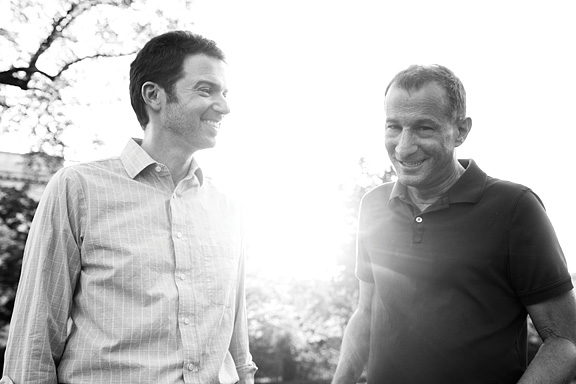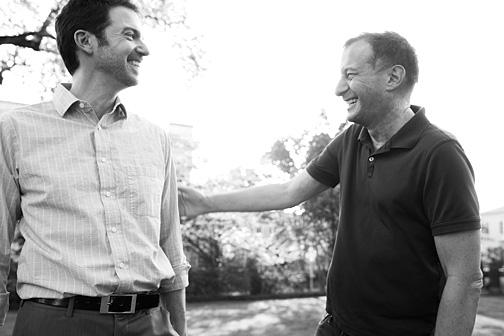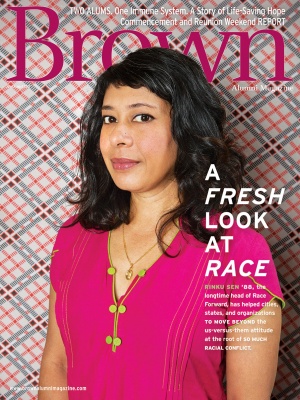David Falk ’94 saved the life of Robert Friedman ’86. That was not exactly his intention.

Oh, he’d hoped when he volunteered to donate his stem cells that they would one day save somebody’s life. But it wasn’t until years later that he found out the life in question belonged to a fellow Brunonian.
“I’m kind of a math guy,” Falk says, in a bit of an understatement. He was a math and American studies double concentrator at Brown and now teaches middle-school math. “So I did some calculations. I estimated that there are probably fifty-seven living Brown classes of roughly 2,500 people each. That’s about 130,000 people. And if there are 310 million people in the United States, then the chance that you would be randomly matched up with someone else who turned out to be a Brown alum—like, if you threw a dart at a phone book—is .04 percent.”
Robert Friedman also faced slim odds, but of a decidedly different kind. In 2001, he was thirty-six and unmarried, so he decided to put all his stuff in storage and travel the world, climbing mountains in Alaska, British Columbia, and South America. In the middle of his adventure, he took a break to go home for Thanksgiving, taking advantage of the visit to deal with some tooth pain. “I’d just seen that crazy Tom Hanks movie Cast Away, and I pictured going back to Ecuador and doing my own dental work,” he says.
What Rob suspected was a cavity or an abscess turned out to be a kind of malignant tumor called an odontogenic carcinoma. Cancer. “It cut the mountain climbing short,” he says.
When the tumor was examined at the lab, the diagnosis was CLL or Chronic lymphocytic leukemia. Because it is a slow-moving form of cancer that rarely afflicts people younger than sixty-five, CLL gets called “the good cancer.” It progresses so slowly that its victims usually die of something else. But, if you contract CLL when you’re young, the danger is far greater, and oncologists usually recommend radical treatment, usually a stem-cell transplant using cells from a donor. “And that’s really scary,” Rob explains. Your body may reject the stem cells, for example, and “you can die from the process. So people put it off.”
Rob put it off. He got back to his life. In 2006 he started a new business, Kirkland West LLC, a global executive search firm. He got married. But the CLL wouldn’t be ignored.
“This thing was coming for me,” he says, “but it was in slow motion—like a train, and you’re tied to the tracks, but the train is 100,000 miles away.” Defective white blood cells collected in his lymph nodes, eventually swelling his armpits and neck. (“I looked like a frog in my worst moments.”)
In 2006, Rob chose to battle the cancer’s progress with chemotherapy. He banked his sperm, which allowed him and his wife, Ellen, to have a daughter, Becca, in 2007 and a son, Charlie, in 2011, around the time he went in for another round of chemo. “It was crazy,” Friedman says, mildly, about his life at that time. And it was about to get crazier.
In about 5 percent of cases—more statistical bad luck—CLL undergoes something called Richter’s transformation, in which the disease morphs into a fast-growing, diffuse, large B-cell lymphoma with a poor prognosis. “It’s when you get the you-have-six-months-to-live-speech,” Rob says. “Unless you get a stem-cell transplant.” Rob wonders if, ironically, it’s the rotten odds that saved his life: “It forced my hand. You can be like, can I successfully jump across this abyss? But if the bridge is burning behind you, you just have to. You jump.”
Stem cells are undifferentiated cells: the building blocks of the body’s systems and organs, which also function as a repair system if one of those systems or organs is damaged. They’re the blank tiles in a Scrabble game, capable of becoming whatever cells you need. The problem, in Rob’s case, is that his own stem cells could only become the same blood cells that couldn’t fight the cancer. Stem cells from a donor should be able to start producing healthy red and white blood cells in your bone marrow, allowing your newly strengthened immune system to start fighting the disease.
Or that’s the theory, anyway. The procedure involves potential complications, including infection from the transplant, rejection of the transplant, and an inability for the new cells to cure the original illness. Thanks to his age and a strong remission from chemotherapy, Rob’s odds of success were better than average: 80 to 90 percent that he would surpass the five-year survival rate. “The problem is,” Rob says, “if someone said to you, ‘Hey, good news, 90 percent of the guests will walk out of this party alive,’ you don’t want to go to that party.”
The morning before his father drove him up to Boston for the transplant, Rob Friedman took his daughter to her first day of kindergarten and kissed her goodbye. “I didn’t know if it was going to be a one-way trip [to Boston],” he says.
This is the part of the story that chokes up Dave Falk, who is also a father of two. Here he was, having checked a stem-cell donor box on a form the last time he’d given blood, having made it through multiple rounds of screening and been chosen as the best possible match for a patient whose identity he didn’t know. Here he was imagining the emotions that patient was going through. And then there were those odds of a match. As Rob put it, “If you drew a seventy-mile radius around Kiev, you’d get all our grandparents.”
Separately, the two men were prepped for the transplant. Rob underwent one more round of chemo to suppress his damaged immune system as much as possible: “For a couple weeks at the Dana Farber Cancer Institute,” he recalls, “I’m the boy in the bubble: a germ-free environment, gloves and masks on visitors, air filtration.”
Dave, meanwhile, needed to stimulate as much stem cell production as possible, so he underwent three days of injections of a drug called Neupogen, which does such a good job that all those stem cells stuffed into your bone marrow can make your bones hurt. As these peripheral blood cells circulate in your blood—the stem cells are not actually harvested from the donor’s bone marrow—they are filtered out in a non-invasive procedure called apheresis, which is a lot like dialysis. Picture blood coming out of an IV in one arm, passing through a centrifugal collection machine, and going back into your body through an IV in your other arm. “It’s basically like giving blood for eight hours, just sitting in a chair,” Falk explains. “It was kind of like being on a long flight—except I had more leg room.”

Two floors up, the bag of Dave’s cells arrived in Rob’s room—along with a rabbi. “He’d come to bless the stem cells!” Friedman laughs. “I’m not exactly devout, but I was like, bring it. Any other religious folks? Please! Bless away.”
Out of one man’s arm and into another’s. Fifteen minutes later it was done. Dave went on with his routines and heard nothing about the fate of the patient receiving his stem cells. And Rob got sicker. “‘Should I be worried?’ I asked,” Rob remembers. “And the Dana Farber people said, ‘Not at all!’ It was all going according to the plan.”
The plan was that Rob’s blood was turning into Dave’s blood, and Dave’s immune system was rebooting Rob’s—but slowly. “You come out of the transplant,” Rob says, “and you have a brand-new immune system. I was on the same vaccination schedule as a baby!”
Eighteen months later, Rob’s maturing immune system started ridding his body of the cancer. After two years out, he was in complete remission.
So whose stem cells had saved his life? Rob wondered. The stem-cell registry has strict rules about contact between donor and patient, but a year after the transplant the patient can petition to contact the donor. Rob wasn’t ready to do that. He had decided to wait until he was well. If things went badly, he’d asked a friend to write Dave a heartfelt thank-you. Now that he was in remission, he wrote the thank-you himself.
Two weeks later, the registry sent Dave’s name. Then Rob did what anyone does to prepare for a blind date these days: he Googled it. That’s when Brown University popped up.
“I just started sobbing,” Rob recalls. “I hadn’t cried until then. It’s not that stem cells from a Brown grad are better than anyone else’s! But it just made sense somehow. It was like the universe was winking at me, saying, ‘It’s going to be okay.’”
Their relatives were from the same part of the world. They’d gone to the same college. They each had a son and a daughter. Now they had the same blood.
Rob, who lives in Scarsdale, New York, drove up to Rhode Island to meet Dave near his home in Cranston. They met for cheesecake, a safe choice for a first date.
“He’s an awesome guy,” Dave says about getting to know Rob. “I’m thrilled. You know, we recycle every day. We try to do the right thing. But you don’t really see anything tangible. But this! This.
“Rob sometimes tells me, ‘You’re a hero,’ and I’m like, ‘Please, don’t say that.’ If anyone’s a hero, it’s him. He had to do all the hard work. I did what anyone who had the time and space in their life would do. It was a few hours of inconvenience to potentially save someone’s life. How could you say no to that?”
Rob describes himself as an optimist. “On an optimism scale of one to ten, I’m a five million,” he says. He believes he is the beneficiary of something he calls “the Dolphin Effect.” It’s a reference to rare accounts of dolphins saving lives, of swimmers carried out to sea by a current and of a pod of dolphins pushing them back toward shore.
“For me,” Rob says, “hundreds of dolphins kept pushing me to shore: family, doctors, nurses, scientists who have developed new drugs and treatments, the guy who cleaned my room and kept it sterile when I had no immune system. The patients who went before me. Fate and a lot of really dumb luck.
“And of course a Brown grad named David Falk, who must have been six years old when I matriculated. Sometimes the universe just works.”
Postscript: As this story went to press, Rob Friedman relapsed. “It’s rare,” he says, “but you can get CLL again, and I did. But there’s been a sea change in CLL treatment. Now there’s basically a pill you can take and you’re fine. So, thanks to David, my new immune system extended my life for long enough for the technology to catch up.”





